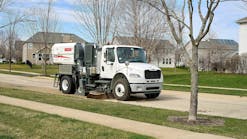Penrith City Council in Australia is now measuring the success of a pilot project utilizing an innovative treatment technique for storm water flow discharging from a mixed residential/semi rural catchment area.
Assisted by the New South Wales Government through its Storm Water Trust, the Scope Creek Olympic Storm Water Project, which began in 1999, can only now be fully measured for its successful impact as part of this progressive project required seedlings to become a fully grown woodlot to act as a nutrient sink.
The woodlot ensures a nutrient uptake on sloping, elevated land along the southern portion of the site and generally stands above the limit of frequent channel flows to ensure satisfactory functional separation.
Key to the entire system is a subterranean SPEL Stormceptor system supplied by All Pumps Sales & Service. All Pumps engineered the solution showing cost effectiveness, modular design and ease of installation at this particular site.
SPEL Stormceptors employ a bypass system. Untreated water containing dirt and oil enters the system and silt sinks to the bottom while the oil floats to the surface.
As the flow increases during heavy rain, the system bypasses an increasing percentage ducted from the cleanest zone in a primary chamber through to a bypass chamber before final discharge.
Significant features include good access to all parts for de-sludging, a dip pipe inlet for minimum turbulence and to prevent inflammable vapours passing upstream, and tank exterior treatment called 'flow coat' that acts as a water penetration barrier.
Scope Creek comprises a catchment of about 2200 hectares which connects just south of Cranebrook Village to the Penrith Lakes Scheme (the Sydney 2000 Olympics rowing and whitewater venue).
Water quality within the active venue elements of the Penrith Lakes Scheme was required to be maintained at near primary contact levels. As such, it was stipulated that contributing catchment inflows should be pre-treated as effectively as possible.
The project addresses litter, sediment, vegetative matter and other similar materials mobilised by stormwater low flows by removal and treatment techniques including gross pollutant/sediment traps, light liquid separators and biological methods.
Treated flows are temporarily stored and then applied to this fully grown woodlot (nutrient sink) on the adjacent land using irrigation techniques.
To fully measure the performance of the grant project works, the Penrith Lakes Development Corporation maintains detailed water quality records under its control and past records are being used as a baseline water quality indicator.
Source: AP






